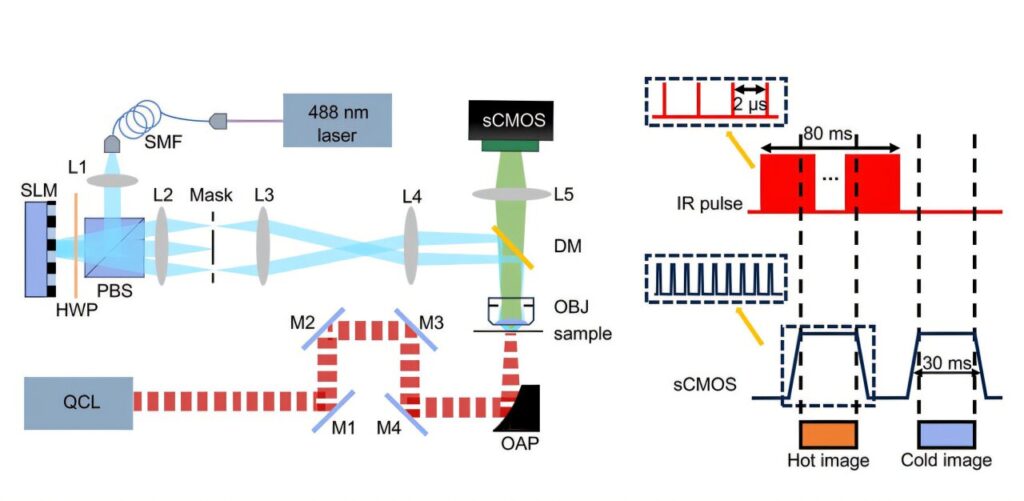Today’s super-resolution microscopes have made it possible to observe the nanoscale world with unprecedented detail. However, they require fluorescent tags, which reveal structural details but provide little chemical information about the samples being studied.
This drawback has driven the development of vibrational imaging techniques, which can identify molecules based on their unique chemical bonds without altering the sample. These methods detect physical changes in samples when they absorb mid-infrared (MIR) light, such as shifts in refractive index caused by heat absorption or temperature-induced acoustic signals. And yet, existing methods often struggle with weak signal levels, making it difficult to achieve both high resolution (how finely details can be seen) and strong chemical contrast (how well molecules can be distinguished).
As reported in Advanced Photonics, a newly developed technique, structured illumination midinfrared photothermal microscopy (SIMIP), now addresses this limitation with two times better resolution than conventional microscopy.
Developed by researchers at Zhejiang University, China, led by Prof. Delong Zhang, the new technique represents a significant advancement in vibrational imaging, opening new possibilities for nanoscale chemical and biological analysis.
Zhang notes, “SIMIP microscopy integrates the principles of structured illumination microscopy with midinfrared photothermal detection. Mid-infrared photodetection provides chemical specificity, while structured illumination microscopy enhances the spatial resolution of the sample.”
The system consists of a quantum cascade laser (QCL) that excites specific molecular bonds, causing localized heating that reduces the brightness of adjacent fluorescent molecules. Simultaneously, a SIM system consisting of a 488-nm continuous-wave laser and a spatial light modulator (SLM) generates striped light patterns that are projected onto the sample at different angles.
These patterns create Moiré fringes, encoding previously unresolvable high-frequency details into detectable low-frequency signals that are captured by a scientific CMOS (sCMOS) camera. By comparing images taken with and without vibrational absorption, SIMIP reconstructs high-resolution images that are rich in both chemical and spatial information.
The team applied Hessian SIM and sparse deconvolution algorithms to achieve a higher spatial resolution, up to ∼60 nm, with an imaging speed of over 24 frames per second, surpassing conventional MIR photothermal imaging.
To validate the accuracy of SIMIP, researchers tested it on 200-nm polymethyl methacrylate beads embedded with thermosensitive fluorescent dyes. By sweeping the QCL across the 1,420–1,778 cm-1 range, SIMIP successfully reconstructed the vibrational spectra, closely matching results from Fourier transform infrared (FTIR) spectroscopy.
In terms of resolution, SIMIP achieved a 1.5-fold improvement over conventional MIR photothermal imaging, with a full width at half-maximum (FWHM) of 335 nm versus 444 nm in standard methods. Moreover, it was able to distinguish between polystyrene and polymethyl methacrylate beads within sub-diffraction aggregates, which was impossible with standard fluorescence microscopy.
An added advantage of SIMIP is its ability to detect autofluorescence—the natural fluorescence emitted by certain biological molecules. This can be achieved by switching from widefield SIM to point-scanning SIM for structured excitation of autofluorescence or by using a shorter-wavelength probe beam for a widefield photothermal detection method to enhance compatibility with existing optical setups.
By integrating SIM with MIP, SIMIP achieves high-speed, super-resolution chemical imaging beyond the diffraction limit. This method opens new possibilities for observations in materials science, biomedical research, and chemical analysis. For example, the researchers envision using SIMIP to detect small-molecule metabolites and analyze their interactions with cellular structures.
The team now plans to enhance SIMIP’s temporal synchronization to further improve imaging speed and accuracy, as well as explore temperature-sensitive dyes to increase sensitivity. With minimal hardware modifications to existing SIM systems, SIMIP is poised for adoption in laboratories worldwide.


